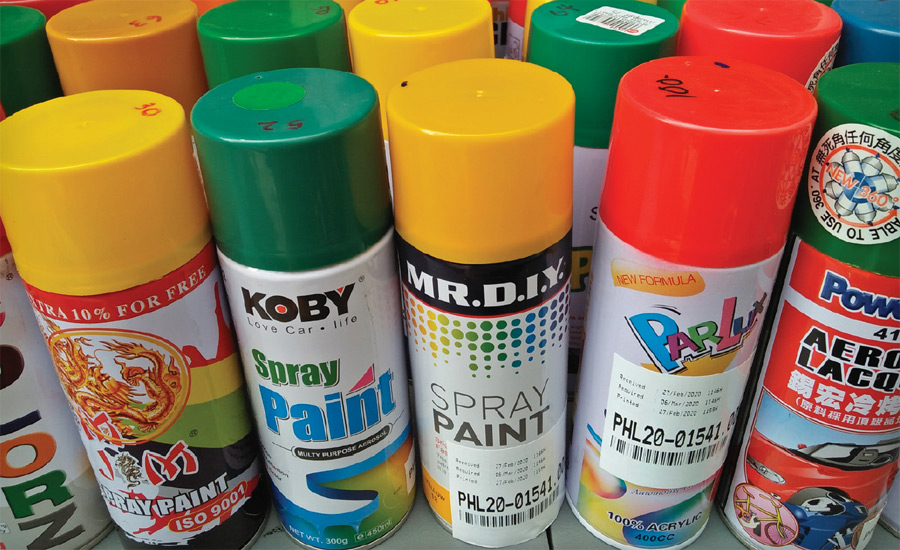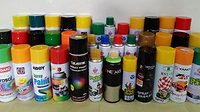Study Finds High Levels of Lead in Spray Paints Sold in Retail Outlets in Philippines

QUEZON CITY, Philippines/GOTHENBURG, Sweden — A new report by the environmental health groups EcoWaste Coalition and International Pollutants Elimination Network (IPEN) finds spray paints with dangerous lead concentrations on sale in the Philippines in violation of the country’s law banning lead in paints.
The report, Lead in Spray Paints for Consumer Use in the Philippines, provides the first publicly available data on the lead content of paints in aerosol cans sold in the country, which are typically used as a touch-up paint for appliances and cars, as a material for school projects, and for sprucing up accessories and decors.
While the hazards of spray paint fumes due to their VOC ingredients like acetone, toluene and xylene, which can be directly inhaled, are known, studies had barely paid attention to lead lurking in such paints, the groups noted.
The report shows that out of 87 analyzed spray paints for consumer or general use, 37 samples exceeded the total lead content limit above 90 parts per million (ppm) of which 29 had dangerous lead concentrations topping 10,000 ppm. The samples were obtained from various retail outlets, including hardware stores, home improvement centers, general merchandise marts, school and office supplies shops, in 20 cities and one municipality in Metro Manila and various parts of Luzon. SGS Philippines conducted the laboratory tests.
As confirmed by the Philippine Association of Paint Manufacturers (PAPM) with the EcoWaste Coalition and IPEN, none of the spray paints analyzed in the study was produced locally by its affiliated companies.
“The unlawful sale of spray paints containing lead points to the need for strict monitoring of business compliance to the Chemical Control Order prohibiting lead content above 90 ppm in all types of paint products. Paints in aerosol cans are definitely not exempted,” said Thony Dizon, Chemical Safety Campaigner, EcoWaste Coalition.
“The authorities need to ensure that only lead-safe paints are sold in the market, as the country has already phased out lead-containing decorative paints in December 2016 and lead containing industrial paints in December 2019. Further efforts are needed to rid the market of non-compliant paint products such as those coming from overseas,” said Derrick Tan, President, PAPM.
“Lead paint is a major source of childhood lead exposure, affecting large numbers of children in the world. To protect children’s health, governments and other stakeholders across the globe, including the Philippines, are taking measures to ban lead in all paints,” said Dr. Sara Brosché, Global Lead Paint Elimination Campaign Manager, IPEN. “Together with the EcoWaste Coalition and PAPM, we support the effective implementation of laws and regulations that will keep children and other vulnerable groups safe from irreparable harms caused by exposure to lead in contaminated paint, dust and soil.”
Exposure to lead, the groups pointed out, can seriously damage the brain. When a young child is exposed to lead, the harm to her or his developing brain and nervous system makes it more likely that the child will have difficulties in school and engage in impulsive and violent behavior. Lead exposure in young children is also linked to increased rates of hyperactivity, inattentiveness, failure to graduate from high school, conduct disorder, juvenile delinquency, drug use and incarceration. The impact of childhood lead exposure continues throughout life and has a long-term impact on a child’s work performance, and is related to decreased economic success.
According to the PAPM, which brings together 72 paint manufacturers and raw materials suppliers, safe and cost-effective substitutes to lead additives are available for all paint categories, making the elimination of lead paint in the Philippines and globally a feasible goal. To assure consumers that their paint products comply with the country’s lead paint law, three leading paint companies in the Philippines have even gone beyond what the regulation requires by successfully obtaining third-party Lead Safe Paint® certification.
Key findings of the study include the following.
- 37 out of 87 analyzed spray paints representing 19 brands were lead paints, i.e., they contained lead concentrations above 90 ppm, dry weight. In addition, 29 paints contained dangerously high lead concentrations above 10,000 ppm.
- 19 out of 37 analyzed brands sold at least one lead paint, i.e., a paint with lead concentration above 90 ppm. Also, 16 of the 37 analyzed brands sold at least one paint with dangerously high lead concentrations above 10,000 ppm.
- 35 of the 73 bright-colored paints were lead paints, i.e., they contained lead concentrations above 90 ppm. Yellow paints were the most hazardous with 14 paints containing lead concentrations greater than 10,000 ppm, while 11 green paints also contained dangerously high lead concentrations above 10,000 ppm.
Key recommendations arising from the study include:
- A call for the Department of Environment and Natural Resources (DENR) to convene a multi-stakeholders’ dialogue to recognize successes, determine gaps and identify steps toward a more effective enforcement of the regulation banning all lead paints;
- A call for paint manufacturers, importers and distributors to take back their remaining stocks of old lead containing paints from all retail outlets;
- A recommendation for paint manufacturers, including those that export to the Philippines, to obtain third-party Lead Safe Paint® certification to assist consumers in making an informed choice when buying paints.
- A call for consumers to insist on their rights to product information and to product safety and to refrain from buying inadequately labeled and uncertified paint products;
- A recommendation for all stakeholders to support policies and programs that will contribute to reduced children’s, women’s and workers’ exposure to lead from lead-containing paint, dust and soil.
Looking for a reprint of this article?
From high-res PDFs to custom plaques, order your copy today!








